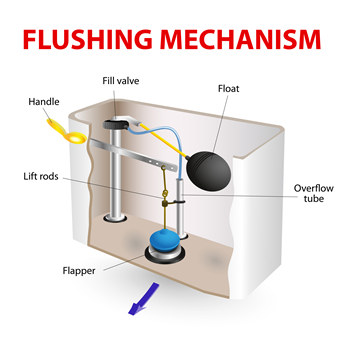Guest post by Joseph Truini
Kids of all ages are naturally curious about everything, and I do mean everything. So, it’s not surprising that bathrooms, with all their water-spurting fixtures and fittings, are of particular interest to inquisitive tots. There’s nothing more mysterious to a child than a toilet. After all, there are so many questions: How does the water get into the toilet? What’s inside the tank? How does the flush handle work? Where does all the water go? Why can’t I put the cat in the toilet?
And what child doesn’t love pushing the handle and hearing that loud and sudden whoosh of water? Flushing is the one thing we never have to ask our children to do twice. However, most parents aren’t exactly sure how a toilet works, so they’re at a loss for answers when being interrogated by a four-year-old. Here, I’ll describe in the most basic terms how a modern toilet works, so you can then explain it to your curious children.
Water In
Water enters the toilet via a cold-water pipe that’s located behind or beneath the toilet tank. The pipe typically extends out of the wall or up through the floor. A shut-off valve is connected to the water pipe and provides a quick, convenient way to turn off the flow of water to the toilet. This is important in case there is an emergency and/or for maintenance reasons. In fact, it’s a good idea that everyone in the house—including children—knows how to find and shut off the valve.
A water-supply tube extends from the shut-off valve to a water-inlet fitting bolted to the underside of the toilet tank. Attached to the inlet fitting inside the tank is a vertical tube, which has a fill valve mounted on top. A narrow hose (fill tube) connects the fill valve to another vertical tube, called the overflow tube.
When the shut-off valve is opened, water flows into the fill valve, through the fill tube, and into the overflow tube. It then exits the bottom of the overflow tube and begins to fill the toilet tank.
As the water level rises, it lifts a round float ball or cylindrical float cup, which is connected to the fill valve. When the water level reaches the proper height, the float ball or cup shuts the fill valve and stops the flow of water. The toilet is now charged and ready for use!
Water Out
Okay, now that you know how water gets into the toilet, let’s see how it’s used to flush the bowl clean. The first flush toilet was developed around 1596, but it didn’t become widely used until the late-19th century. It’s interesting to note that throughout all those centuries, and right up to today, the toilet has worked—and worked reliably—because of one of the most powerful and constant forces in the universe: gravity.
Most modern toilets are known as gravity-fed toilets, meaning that the natural force of gravity is employed to move water from the tank to the bowl, and then out of the bowl and down the drainpipe. There’s no motor or mechanized device of any sort required, just gravity.
If you peek inside the tank and then flush the toilet, you’ll see exactly how it all works. (See the illustration below for more detail.) When the flush handle is depressed, it raises a vertical lift rod or length of chain that’s attached to a round rubber flapper. The flapper fits over the flush-valve seat, which is the large drain hole that connects the tank to the bowl.
When you flush the toilet, the flapper is raised off the valve seat and the entire tank of water quickly and forcefully—thanks to gravity—rushes into the toilet to flush the bowl clean. As the water level lowers, the float ball drops and opens the fill valve, which starts the flow of water back into the tank. In about 30 seconds or so the tank is full, the fill valve shuts off, and the toilet is ready for the next user.
The gravity-fed system is remarkably reliable, but sooner or later you’ll have to deal with a clogged toilet. (After all, even the very best toilets can’t flush Barbie down the drain.) Most common clogs can be cleared with a plunger, but be sure to use a toilet plunger, which is specially designed to fit deep inside toilet bowls.
For stubborn clogs that can’t be cleared with a plunger, use a tool called a toilet auger. An auger is a 6-foot-long flexible steel cable (snake) attached to a crank-handled shaft. Push the snake into the toilet bowl and then crank the handle to drive the end of the snake through the clog. Repeat several times, driving the snake deeper with each attempt. Retract the snake and flush the toilet two or three times to flush away the dislodged clog.
 The inner workings of a modern, gravity-fed toilet.
The inner workings of a modern, gravity-fed toilet.
Beyond Gravity
As mentioned earlier, most of the toilets found in homes today rely on gravity. However, there’s another type worth mentioning, called a pressure-assist toilet. This type of toilet relies on water and air pressure, not gravity, to flush the bowl clean.
Inside the tank is a large bladder that stores air under pressure. The bladder is pressurized either by the rising water level or an electric pump, depending on the model. When the toilet is flushed, the pressurized air is released, and a sudden blast of air and water shoots into the bowl.
Pressure-assist toilets clean better and use less water than standard gravity-fed toilets. But they cost more to buy and the pressure-blasts can damage old, weak pipes. The biggest drawback, however, is that pressure-assist toilets are loud. (Think airplane toilets.) Sure, kids might love the water-cannon noise, but it’s loud enough to startle an individual and/or awaken an entire family at night.
Like many mysteries, the toilet isn’t mysterious at all upon closer examination. In fact, it’s ingeniously simple in both design and function.
Joe Truini is a home improvement expert who writes about a variety of topics related to carpentry and plumbing. He is also the author of numerous DIY books, including the best-selling Building a Shed. Mr. Truini also writes for Home Depot.
Home Depot carries a wide selection of tools and supplies to unclog a toilet, whatever the obstruction.
Latest Posts

Guest Post by Gabriel Morse For several years, I sat for long hours every day behind one of those battleship gray desks in a windowless, dull, gray office. The pay was enough to take care…
Read more >
This post is sponsored by Little Monsters Universe. I'm Tina Salmanowitz, an advocate for homeschooling and science education. With over a decade of experience as a science educator (in class…
Read more >
This post is sponsored by Time4Learning. Before the pandemic, it was business as usual for Boca Raton resident Nikki Warris. Her two daughters, 5-year-old Natalie and 8-year-old Lexi were…
Read more >

